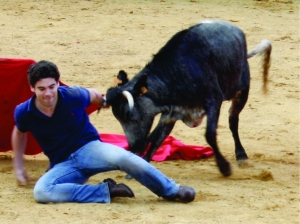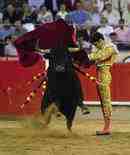BLOOD, SWEAT AND TEARS
INTO THE ARENA: THE WORLD OF THE SPANISH BULLFIGHT
By Alexander Fiske-Harrison
(Profile Books 284pp £15.99)
YOU MIGHT THINK that Ernest Hemingway had bulls and Spain all wrapped up, but it is fifty years now since The Dangerous Summer, his study of two bullfighting brothers-in- law, was first published and more than eighty since his novel Fiesta, about a group of friends who go to watch the running of the bulls in Pamplona. Spain has changed immeasurably since then, shaking off the ‘black legend’ that for centuries branded it as a backward, fervid, superstitious and cruel society.
Yet some elements of superstition, fervour and cruelty still shape Spanish culture and none more so than bullfighting. The question of whether a modern society should endorse animal suffering as entertainment is bound to cross the mind of any casual visitor to a bullfight.
Alexander Fiske-Harrison first tussled with the issue in his early twenties and, as a student of both philosophy and biology, has perhaps tussled with it more lengthily and cogently than most of us. The germ of this book was an essay in Prospect (a ‘rather longwinded’ one, by his own admission). Into the Arena is an attempt to take the bull more firmly by the horns. In researching it, Fiske-Harrison spent nearly two years following a clutch of toreros, several of whom became his friends. He studied their art and learned some of it himself, all the while trying to come to a decision about the morality of a sport that is also an art form.
His eye-witness reports of bullfights are particularly good. He transposes the spectacle into words with great success, conveying the drama of the corrida while explaining individual moves and techniques with eloquence and precision. One bull is ‘a paranoia of horn and muscle’.He is also knowledgeable about the different breeds of bull, some more deadly than others, and the great families whose names are synonymous with breeding bulls and fighting them. I didn’t know that bulls bred to fight never see a person on foot – only ever mounted – until they are in the arena. Bullfights in Seville are preceded by an announcement: ‘Silence! A man risks his life here today.’ I didn’t know that Orson Welles had trained as a bullfighter in Seville for four months under the name El Americano, or that the sport nowadays turns over 2.5 billion euros a year and employs 200,000 people for 2,000 fights. That’s a threefold increase since Hemingway’s time. And it’s strangely heartening to know that if you walk past a policeman in Seville carrying a half-concealed sword he will just smile and cry ‘torero!’.
Outside the arena Fiske-Harrison is less sure-footed. His conversations with off-duty bullfighters rarely get further than the ‘why do you do it?’ stage and seem to take place at social functions where it is hard to establish any intimacy. I wanted to know about these men’s homes, their families, their priests and the surgeons who patch them up time and again (many bullfighters have only one testicle apparently). We learn that a Madrid psychiatrist has found that the brains of bullfighters exhibit a similar neurochemical balance to those of prisoners classified as clinical psychopaths. Are bullfighters psychopaths then? It would be interesting to learn more.
I liked Fiske-Harrison much more in the final chapter, where he questions himself and his project. ‘As a spectator, I was always afraid I was missing something. As a protagonist, I was always … well, just afraid.’ Suddenly I felt I understood why Alexander Fiske-Harrison had wanted to learn to be a bullfighter, and to fight a young bull in front of his parents in Spain. He did it as a tribute to his brother, who was killed while practising another dangerous sport, skiing. I think he wanted to confront danger and survive, as his brother had not. It makes the final sentences of the book all the more poignant: ‘[If] your heart goes out to the bull, as it should, let it also go to the matador. For it is he who is your brother.’
The Spectator: Simon Courtauld, June 25th, 2011
Art and the raging bull
In these days of growing concern at the methods of factory farming and the welfare of the animals which are raised and killed for our consumption, it is instructive to compare the life of domestic beef cattle with that of a Spanish fighting bull. The cattle may have less than two years of life in cramped conditions, while the toro bravo roams free and unmolested on pasture for five years. Alexander Fiske- Harrison makes the comparison succinctly: ‘Five years on free-release and then the arena, or 18 months in prison and then the electric chair’. He maintains (there is some evidence for this, to do with beta-endorphins) that the fighting bull’s suffering is reduced because, once in the ring, it feels no fear, only aggressive anger. Ban the bullfight and this magnificent breed of animal would cease to exist. It is not a good converter of grass into protein, and anyway far too dangerous to be bred only for meat and milk.
The case for what in Spain is called la corrida de toros is well made in this entertaining account of two years which the author spent in Spain — following the bulls, caping young cows himself, getting to know matadors, attending ferias and flamenco parties. An initially reluctant convert to this Spanish cultural tradition, he comes to accept that ‘part of the justification of the suffering is the art’. When- ever he sees a bad and bloody corrida, however, his doubts over the cruelty surface again. Every aficionado has seen fights which are both shameful and plain boring. But when everything goes right, the spectacle can be absorbing, uplifting, even emotional.
What Fiske-Harrison seeks, as someone wrote of the great torero Antonio Ordoñez, is ‘a demonstration of the values which distinguish bullfighting from butchery’. Those values are concerned with technique, artistry, grace under pressure from a highly dangerous animal which is doing its best to kill its adversaries. In conversation with one of Ordoñez’s matador grandsons, Cayetano, the author learns of ‘the warmth a great bull could inspire in him, of his sadness at killing’.
Having returned to Oxford and read books on animal rights, he decides, that he must go back to Spain and kill a bull himself. Coached by a former matador, Dávila Miura, Fiske-Harrison proves himself brave and competent enough to reach what the Spanish call la hora de la verdad, the moment of truth, when he puts his bull to the sword and gains some understanding of what Cayetano had told him.
The only disappointment of this book is that it has a little too much about the author rather than ‘the world of the Spanish bullfight’. He might have considered the significance of religion — almost all bullfighting ferias are held in honour of a saint, or a festival such as Pentecost or Corpus Christi — the effect of the economic recession on the future of la fiesta brava, and of the ban in Catalonia (probably minimal: the encouraging response of the socialist government in Madrid was to hand over responsibility for bullfighting to the Ministry of Culture). He might also have discussed the ever-growing popularity of the corrida in south-west France, where it is conducted precisely as in Spain, and exploded the myth that bullfighting survives for the entertainment of foreign tourists. (When I attended a fight last summer in Malaga — the centre of tourism on the Costa del Sol — with a capacity audience of 12,000, I saw no foreigners there, nor heard a word of English spoken.)
Among the principal toreros of today, Fiske-Harrison gives brief mention to the two — Enrique Ponce and El Juli — who have dominated the scene for the past decade, and the faintest praise to José Maria Manzanares, who has emerged recently as both a consummate artist and master swordsman. One of the book’s best passages — which bears comparison with Kenneth Tynan’s outstanding book, Bull Fever — is the description of a performance by the controversial José Tomás in Jerez. This so-called phenomenon, or suicidal lunatic, having lost 17 pints of blood from a horrible goring in Aguascalientes, Mexico last year, is due to make his comeback in Valencia next month.




